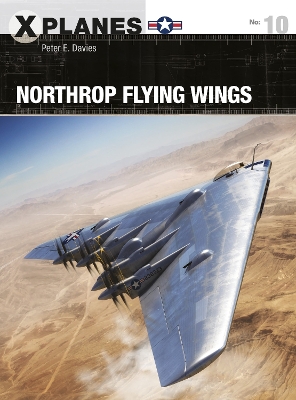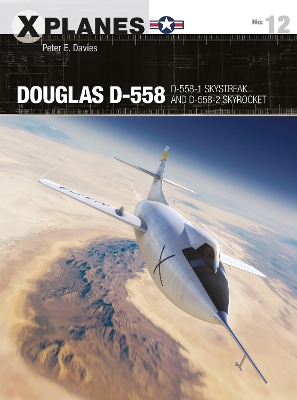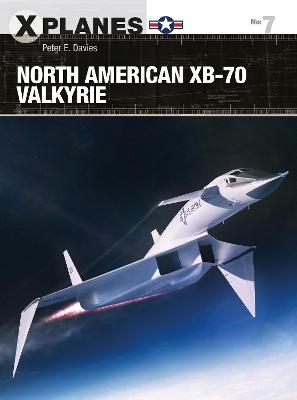X-Planes
5 primary works • 6 total works
Book 1
In 1947, no one knew if it was possible to break the 'sound barrier'. The Bell X-1 was the tiny, rocket-powered craft that finally broke it. It was the result of innovative designers and engineers turning their attention from the pioneering jets of World War II to a new task - an aircraft designed purely to fly faster than sound. Legendary pilots rallied to the cause, with World War II ace Chuck Yeager piloting the X-1 when it finally achieved supersonic flight in 1947, the first manned craft to reach such speeds. With historical photographs and meticulously researched digital art, Peter Davies traces the whole career of the pioneering Bell X-1, from its early development through to the influence it had on military and civilian jets in the second half of the 20th century.
Book 3
The revolutionary X-15 remains the fastest manned aircraft ever to fly. Built in the two decades following World War II, it was the most successful of the high-speed X-planes. The only recently broken 'sound barrier' was smashed completely by the X-15, which could hit Mach 6.7 and soar to altitudes above 350,000ft, beyond the edge of space. Several pilots qualified as astronauts by flying above 50 miles altitude in the X-15, including Neil Armstrong, the first man on the Moon. The three X-15s made 199 flights, testing new technologies and techniques which greatly eased America's entry into manned space travel, and made the Apollo missions and Space Shuttle viable propositions. With historical photographs and stunning digital artwork, this is the story of arguably the greatest of the X-Planes.
Book 6
Even before the spectacular success of its X-1 rocket-powered aircraft in breaking the 'sound barrier', the adventurous Bell Aircraft Corporation was already pushing ahead with a parallel project to build a second aircraft capable of far higher speeds. The X-2 (or Model 52) explored the equally uncertain technology of swept-back wings. Now common in modern conventional fighter aircraft, the Bell X-2 was revolutionary in using this type of airframe to probe Mach 3 and research the effects of extreme aerodynamic friction heat on airframes.
Although both X-2s were destroyed in crashes after only 20 flights, killing two test pilots, the knowledge gained from the programme was invaluable in developing aircraft that could safely fly at such speeds. Using stunning artwork and historical photographs, this is the story of the plane that ultimately made the Lockheed Blackbird and Concorde possible.
Although both X-2s were destroyed in crashes after only 20 flights, killing two test pilots, the knowledge gained from the programme was invaluable in developing aircraft that could safely fly at such speeds. Using stunning artwork and historical photographs, this is the story of the plane that ultimately made the Lockheed Blackbird and Concorde possible.
Book 10
Half a century before the 'flying wing' B-2 stealth bomber entered service, John K. 'Jack' Northrop was already developing prototypes of a large 'flying wing' strategic bomber, which would have been the most radical bombers of their age.
World War II brought a need for very long-range bombers and Northrop received a contract for a 172-ft span bomber, the B-35. Several of these were built, gradually evolving into the definitive XB-35 configuration. Testing revealed that the aircraft was invisible to radar, but engineers struggled to overcome the design challenges and several pilots were lost in crashes. While the program was cancelled in the 1950s, the concept extended into other highly innovative areas, such as the XP-56 and MX-324 Rocket Wing prototype fighters. But the greatest legacy was the first operational flying wing - the Northrop Grumman B-2 stealth bomber, which used much of the hard-won experience from the pioneering programs of half a century before.
World War II brought a need for very long-range bombers and Northrop received a contract for a 172-ft span bomber, the B-35. Several of these were built, gradually evolving into the definitive XB-35 configuration. Testing revealed that the aircraft was invisible to radar, but engineers struggled to overcome the design challenges and several pilots were lost in crashes. While the program was cancelled in the 1950s, the concept extended into other highly innovative areas, such as the XP-56 and MX-324 Rocket Wing prototype fighters. But the greatest legacy was the first operational flying wing - the Northrop Grumman B-2 stealth bomber, which used much of the hard-won experience from the pioneering programs of half a century before.
Book 12
The six Douglas D-558 research aircraft, built as two variants, were produced for a US Navy and NACA collaborative project to investigate flight in the high subsonic and supersonic regimes and to develop means of coping with the dangerous phenomena of compressibility and pitch-up which had caused many accidents to early jets. Wind tunnels could not provide the necessary data so pilots had to risk their safety in experimental aircraft which, for their time, achieved phenomenal performance.
Both series of D-558 were well-designed, strong and efficient aircraft which enabled test pilots to tackle the unknown in comparative safety. Though delayed by their innovative but troublesome power-plants, and limited by the cost of their air-launched sorties, they went well beyond their original Mach 1 speed objective and continued to generate information that provided design solutions for a whole generation of supersonic combat aircraft. Although the final stage of the D-55 programme, the USN's 'militarized' D-558-3, never happened, the Navy was able to apply the lessons of the programme to its much more practical combat types such as the F8U Crusader and F3H Demon.
Supported by full-colour artwork including three-view plates of the two D-558 models and a technical view of the D-2 cockpit, this authoritative text offers a comprehensive guide to the record-breaking Navy research craft.
Both series of D-558 were well-designed, strong and efficient aircraft which enabled test pilots to tackle the unknown in comparative safety. Though delayed by their innovative but troublesome power-plants, and limited by the cost of their air-launched sorties, they went well beyond their original Mach 1 speed objective and continued to generate information that provided design solutions for a whole generation of supersonic combat aircraft. Although the final stage of the D-55 programme, the USN's 'militarized' D-558-3, never happened, the Navy was able to apply the lessons of the programme to its much more practical combat types such as the F8U Crusader and F3H Demon.
Supported by full-colour artwork including three-view plates of the two D-558 models and a technical view of the D-2 cockpit, this authoritative text offers a comprehensive guide to the record-breaking Navy research craft.
Of the many futuristic military aircraft concepts created in the 1950s the North American XB-70 still stands out as the most awe-inspiring. With its huge, white partially-folding delta wing, its fuselage resembling a striking cobra and its extraordinary performance, it was one of the foremost technological achievements of the 20th Century.
A strategic bomber built to outrun any Soviet fighter jet, it could reach Mach 3 with a full nuclear payload - as fast as the legendary SR-71 Blackbird but more than three times the size. However, its role as a nuclear bomber was limited after the introduction of Intercontinental Ballistic Missiles, and defence cuts eventually led to the project being scrapped in the mid-1960s.
The Valkyrie had a brief, costly decade of life but it proved the continuing value of developing manned bombers. However, almost half a century after the XB-70 its predecessor, the B-52, continues in service. Using full colour artwork and rigorous analysis, this is the complete story of the ultimate US Cold War military X-plane.
A strategic bomber built to outrun any Soviet fighter jet, it could reach Mach 3 with a full nuclear payload - as fast as the legendary SR-71 Blackbird but more than three times the size. However, its role as a nuclear bomber was limited after the introduction of Intercontinental Ballistic Missiles, and defence cuts eventually led to the project being scrapped in the mid-1960s.
The Valkyrie had a brief, costly decade of life but it proved the continuing value of developing manned bombers. However, almost half a century after the XB-70 its predecessor, the B-52, continues in service. Using full colour artwork and rigorous analysis, this is the complete story of the ultimate US Cold War military X-plane.





